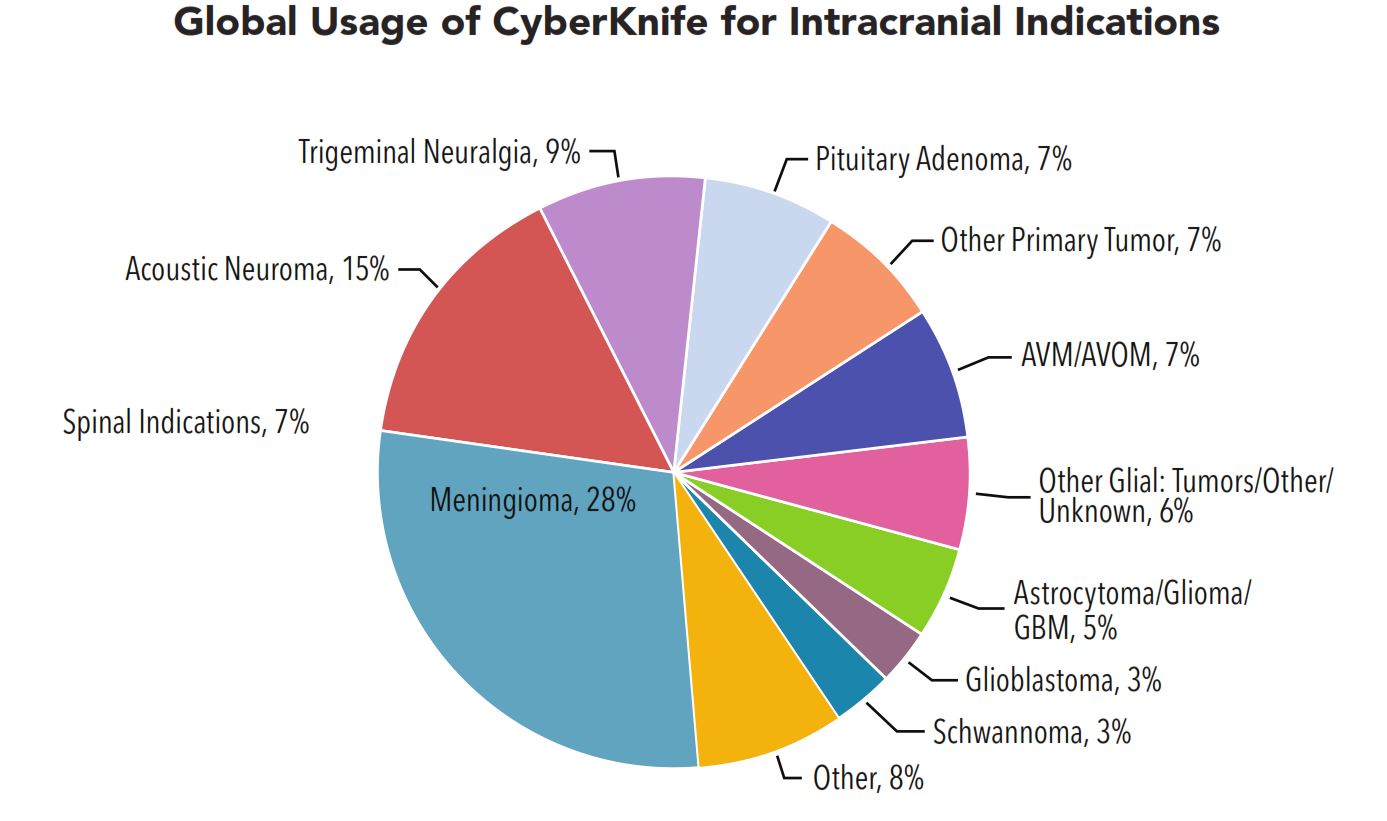Brain Cancer
CyberKnife Brain Tumor Treatment Explained
CyberKnife vs. Gamma Knife
The CyberKnife System and Gamma Knife are two of the treatment options for brain cancer. Find out more about the differences between CyberKnife and Gamma Knife here.

Treating Brain Tumors
If doctors determine that you have a tumor, the treatment options and prognosis are based on the following factors:
- Tumor type
- Location and size of tumor
- Tumor grade (how abnormal the cells are)
- Your age, medical history and general health
Understanding Radiation Therapy
Radiation therapy, sometimes called radiotherapy, is the careful use of radiation to safely and effectively treat many different kinds of tumors.
- Doctors called radiation oncologists use radiation therapy to try to kill tumors, to control tumor growth or to relieve symptoms.
- Radiation therapy works within tumor cells by damaging their ability to multiply. When these cells die, the body naturally eliminates them.
- Healthy cells near the tumor may be affected by radiation, but they are able to repair themselves in a way tumor cells cannot.
Radiation Therapy Options for Brain Tumors
People with brain tumors should discuss treatment options with a number of cancer specialists, including a radiation oncologist. A radiation oncologist is a doctor who will help you understand the types of radiation therapy available to treat your tumor. Radiation therapy treatment options for brain tumors include:
- External beam radiation therapy
- Brachytherapy or internal radiation therapy
- Depending on your tumor, you may also undergo surgery and/or chemotherapy, either before or after radiation
External Beam Radiation Therapy
External beam radiation therapy involves a series of daily outpatient treatments over several weeks to accurately deliver radiation to the brain. Radiation is often given after surgery, and sometimes it is used instead of surgery.
- 3-dimensional conformal radiotherapy (3D-CRT) combines multiple radiation treatment fields to deliver precise doses of radiation to the brain. Tailoring each of the radiation beams to the patient's tumor allows coverage of the diseased cells while keeping radiation away from nearby organs, such as the eyes.
- Intensity modulated radiation therapy (IMRT) is the most recent advance in the delivery of radiation. IMRT differs from 3D-CRT by modifying the intensity of the radiation within each of the radiation beams.
- Stereotactic radiotherapy, sometimes called radiosurgery, is a type of external beam radiation therapy that pinpoints high doses directly on the tumor, in some cases in only one treatment. At some centers, stereotactic radiotherapy is called by the name of the company that makes the equipment.
X-rays, electrons and protons are all types of energy used in external beam radiation therapy.
Internal Radiation Therapy
Internal radiation therapy, or brachytherapy, works by placing radioactive sources in, or just next to, a tumor.
- During brachytherapy, a tube or balloon called a catheter will be inserted into the brain. The radiation will then be carried to the tumor using this catheter.
- The radioactive source will then be left in place from several hours to several days to kill the tumor cells.
- In some cases, the radiation is permanently placed directly into the tumor or the area where the tumor was before surgery.
Newer Techniques
Doctors are constantly exploring newer and better ways to treat primary brain tumors.
- Drugs that make tumor cells more sensitive to radiation are called radiosensitizers. Combining radiation with radiosensitizers may allow doctors to kill more tumor cells.
Possible Side Effects
- Side effects from radiation can include fatigue, hair loss where you received radiation, scalp irritation and muffled hearing. These will usually resolve a month or so after treatment. However, you hair might not grow back exactly as it was before treatment.
- Radiation may also cause some short-term memory loss and difficulty thinking.
- Side effects are different for each person. Medications may be prescribed to make you as comfortable as possible.
- If at any time during your treatment you feel discomfort, tell your doctor or nurse. They can prescribe medicine to help you feel better.
Be sure to talk to your radiation oncologist before you start treatment, to make sure you understand what side effects are common for your treatment and how best to handle them.
Caring for Yourself During Treatment
- Get plenty of rest during treatment, and don't be afraid to ask for help.
- Follow your doctor's orders. Ask if you are unsure about anything. There are no stupid questions.
- Tell your doctor about any medications or vitamins you are taking, to make sure they are safe to use during radiation therapy.
- Eat a balanced diet. If food tastes funny or if you're having trouble eating, tell your doctor, nurse or dietician. They may be able to help you change the way you eat.
- Treat the skin exposed to radiation with special care. Stay out of the sun, avoid hot or cold packs, only use lotions and ointments after checking with your doctor or nurse, and clean the area with warm water and mild shampoo or baby shampoo.
- Battling cancer is tough. Seek our help from support groups and friends.
What is Brain Cancer?
The brain is the center of thought, memory, emotion, speech, sensation and motor function. The spinal cord and special nerves in the head called cranial nerves carry and receive messages between the brain and the rest of the body.
There are two types of brain tumors:
- Primary — a tumor that starts in the brain. Primary brain tumors can be benign (not cancerous) or malignant (cancerous). Primary tumors in the brain or spinal cord rarely spread to distant organs.
- Metastatic — a tumor caused by cancer elsewhere in the body that spreads to the brain. Metastatic brain tumors are always cancerous.
Brain tumors cause damage because, as they grow, they can interfere with surrounding cells that serve vital roles in our everyday life.
What Should I Expect at Phoenix CyberKnife?
The Team
CyberKnife brain cancer treatments involve a team approach, in which several specialists participate. The team may include:
- Radiation Oncologist
- Neurosurgeon
- Medical Physicist
- Radiation Therapist
- Clinical Care Nurse Coordinator
Once the team is in place, preparations begin for the CyberKnife treatment. Generally there are three steps involved:
- Set up and imaging
- Treatment planning
- CyberKnife treatment
Preparation
Unlike other radiosurgery systems – such as the Gamma Knife – the CyberKnife System does not require patients to be fitted with a rigid and invasive head frame. In the set-up stage, the radiation therapist will create a soft mesh mask that is custom-fitted to the patient’s face. This comfortable and non-invasive mask helps the patient keep his or her head and neck immobile during treatment. While wearing the mask, a CT scan will be performed. The CT data will be fused with other image data sets such as MRIs or PET scans. Thes fused images sets will then will be used by the CyberKnife team to determine the exact size, shape and location of the tumor.
An MRI, PET scan or angiogram also may be necessary to fully visualize the tumor and nearby anatomy. Once the imaging is done, the face mask will be removed and stored until the CyberKnife treatment begins. Then a medical physicist and the patient’s radiation oncologist use the data to custom-design the patient’s treatment plan. The patient does not need to be present for the treatment planning.
During the CyberKnife treatment planning phase, the CT, MRI and/or PET scan data will be downloaded into the CyberKnife System’s treatment planning software. The medical team will determine the size of the area that must be targeted by radiation and the radiation dose. They also will identify critical structures where radiation should be minimized. Using this information, the CyberKnife System calculates the optimal radiation delivery plan to treat the tumor. The treatment plan will take full advantage of the CyberKnife System’s extreme maneuverability, allowing for a safer and more accurate treatment.
Treatments
After the brain cancer treatment plan is developed, the patient will return to the CyberKnife Center for treatment. The Radiation Oncologist may choose to deliver the treatment in one session, or stage it over two to five days. All, brain cancer treatments are completed within five days. For most patients, the CyberKnife treatment is a completely pain-free experience. Patients dress comfortably in their own clothes and, depending on the treatment center, they may be allowed to bring music to listen to during the treatment. Patients also may want to bring something to read while they wait, and have a friend or family member with them to provide support before and after treatment.
When it is time for treatment, the patient lies on the table while their custom-fitted face mask is secured into place. The CyberKnife System’s computer-controlled robot will move around the patient’s body to the various locations from which it will deliver radiation to the tumor. Nothing will be required of the patient during the treatment, except to relax and lie as still as possible.
After Treatment
Once the CyberKnife treatment is complete, most patients quickly return to their daily routines with little interruption in their normal activities. If the treatment is being delivered in stages, the patient will need to return for additional treatments over the next several days, as recommended by their Radiation Oncologist. Side effects vary from patient to patient. Generally some patients experience minimal side effects from CyberKnife treatments, and these often go away within a week or two. Prior to treatment, the Radiation Oncologist will discuss with the patient all possible side effects they may experience. The Radiation Oncologist also may prescribe medication designed to control any side effects should they occur.
After completing CyberKnife radiosurgery treatment, it is important that the patient schedule and attend follow-up appointments. They also must keep in mind that their tumor will not suddenly disappear. Response to treatment varies from patient to patient. Clinical experience has shown that most patients respond very well to CyberKnife treatments. As follow-up, Radiation Oncologists will monitor the outcome in the months and years following a patient’s treatment, often using either CT scans and/or PET-CT scans.
Patient Education
CyberKnife - Brain, Head & Neck Cancer
TrueBeam STx - Brain, Head & Neck Cancer
TrueBeam STx - Animation
CyberKnife - Spine Cancer
CyberKnife explained by Neurosurgeons
Patient Testimonials
Richard 's CyberKnife Treatment Trigeminal Neuralgia
CyberKnife Treatment Acoustic Neuroma (AN)
Rachael's CyberKnife Treatment Chordoma Spinal Tumor
CyberKnife Brain Tumor Treatment Explained
CyberKnife vs. Gamma Knife
The CyberKnife System and Gamma Knife are two of the treatment options for brain cancer. Find out more about the differences between CyberKnife and Gamma Knife here.

Treating Brain Tumors
If doctors determine that you have a tumor, the treatment options and prognosis are based on the following factors:
- Tumor type
- Location and size of tumor
- Tumor grade (how abnormal the cells are)
- Your age, medical history and general health
Understanding Radiation Therapy
Radiation therapy, sometimes called radiotherapy, is the careful use of radiation to safely and effectively treat many different kinds of tumors.
- Doctors called radiation oncologists use radiation therapy to try to kill tumors, to control tumor growth or to relieve symptoms.
- Radiation therapy works within tumor cells by damaging their ability to multiply. When these cells die, the body naturally eliminates them.
- Healthy cells near the tumor may be affected by radiation, but they are able to repair themselves in a way tumor cells cannot.
Radiation Therapy Options for Brain Tumors
People with brain tumors should discuss treatment options with a number of cancer specialists, including a radiation oncologist. A radiation oncologist is a doctor who will help you understand the types of radiation therapy available to treat your tumor. Radiation therapy treatment options for brain tumors include:
- External beam radiation therapy
- Brachytherapy or internal radiation therapy
- Depending on your tumor, you may also undergo surgery and/or chemotherapy, either before or after radiation
External Beam Radiation Therapy
External beam radiation therapy involves a series of daily outpatient treatments over several weeks to accurately deliver radiation to the brain. Radiation is often given after surgery, and sometimes it is used instead of surgery.
- 3-dimensional conformal radiotherapy (3D-CRT) combines multiple radiation treatment fields to deliver precise doses of radiation to the brain. Tailoring each of the radiation beams to the patient's tumor allows coverage of the diseased cells while keeping radiation away from nearby organs, such as the eyes.
- Intensity modulated radiation therapy (IMRT) is the most recent advance in the delivery of radiation. IMRT differs from 3D-CRT by modifying the intensity of the radiation within each of the radiation beams.
- Stereotactic radiotherapy, sometimes called radiosurgery, is a type of external beam radiation therapy that pinpoints high doses directly on the tumor, in some cases in only one treatment. At some centers, stereotactic radiotherapy is called by the name of the company that makes the equipment.
X-rays, electrons and protons are all types of energy used in external beam radiation therapy.
Internal Radiation Therapy
Internal radiation therapy, or brachytherapy, works by placing radioactive sources in, or just next to, a tumor.
- During brachytherapy, a tube or balloon called a catheter will be inserted into the brain. The radiation will then be carried to the tumor using this catheter.
- The radioactive source will then be left in place from several hours to several days to kill the tumor cells.
- In some cases, the radiation is permanently placed directly into the tumor or the area where the tumor was before surgery.
Newer Techniques
Doctors are constantly exploring newer and better ways to treat primary brain tumors.
- Drugs that make tumor cells more sensitive to radiation are called radiosensitizers. Combining radiation with radiosensitizers may allow doctors to kill more tumor cells.
Possible Side Effects
- Side effects from radiation can include fatigue, hair loss where you received radiation, scalp irritation and muffled hearing. These will usually resolve a month or so after treatment. However, you hair might not grow back exactly as it was before treatment.
- Radiation may also cause some short-term memory loss and difficulty thinking.
- Side effects are different for each person. Medications may be prescribed to make you as comfortable as possible.
- If at any time during your treatment you feel discomfort, tell your doctor or nurse. They can prescribe medicine to help you feel better.
Be sure to talk to your radiation oncologist before you start treatment, to make sure you understand what side effects are common for your treatment and how best to handle them.
Caring for Yourself During Treatment
- Get plenty of rest during treatment, and don't be afraid to ask for help.
- Follow your doctor's orders. Ask if you are unsure about anything. There are no stupid questions.
- Tell your doctor about any medications or vitamins you are taking, to make sure they are safe to use during radiation therapy.
- Eat a balanced diet. If food tastes funny or if you're having trouble eating, tell your doctor, nurse or dietician. They may be able to help you change the way you eat.
- Treat the skin exposed to radiation with special care. Stay out of the sun, avoid hot or cold packs, only use lotions and ointments after checking with your doctor or nurse, and clean the area with warm water and mild shampoo or baby shampoo.
- Battling cancer is tough. Seek our help from support groups and friends.
What is Brain Cancer?
The brain is the center of thought, memory, emotion, speech, sensation and motor function. The spinal cord and special nerves in the head called cranial nerves carry and receive messages between the brain and the rest of the body.
There are two types of brain tumors:
- Primary — a tumor that starts in the brain. Primary brain tumors can be benign (not cancerous) or malignant (cancerous). Primary tumors in the brain or spinal cord rarely spread to distant organs.
- Metastatic — a tumor caused by cancer elsewhere in the body that spreads to the brain. Metastatic brain tumors are always cancerous.
Brain tumors cause damage because, as they grow, they can interfere with surrounding cells that serve vital roles in our everyday life.
What Should I Expect at Phoenix CyberKnife?
The Team
CyberKnife brain cancer treatments involve a team approach, in which several specialists participate. The team may include:
- Radiation Oncologist
- Neurosurgeon
- Medical Physicist
- Radiation Therapist
- Clinical Care Nurse Coordinator
Once the team is in place, preparations begin for the CyberKnife treatment. Generally there are three steps involved:
- Set up and imaging
- Treatment planning
- CyberKnife treatment
Preparation
Unlike other radiosurgery systems – such as the Gamma Knife – the CyberKnife System does not require patients to be fitted with a rigid and invasive head frame. In the set-up stage, the radiation therapist will create a soft mesh mask that is custom-fitted to the patient’s face. This comfortable and non-invasive mask helps the patient keep his or her head and neck immobile during treatment. While wearing the mask, a CT scan will be performed. The CT data will be fused with other image data sets such as MRIs or PET scans. Thes fused images sets will then will be used by the CyberKnife team to determine the exact size, shape and location of the tumor.
An MRI, PET scan or angiogram also may be necessary to fully visualize the tumor and nearby anatomy. Once the imaging is done, the face mask will be removed and stored until the CyberKnife treatment begins. Then a medical physicist and the patient’s radiation oncologist use the data to custom-design the patient’s treatment plan. The patient does not need to be present for the treatment planning.
During the CyberKnife treatment planning phase, the CT, MRI and/or PET scan data will be downloaded into the CyberKnife System’s treatment planning software. The medical team will determine the size of the area that must be targeted by radiation and the radiation dose. They also will identify critical structures where radiation should be minimized. Using this information, the CyberKnife System calculates the optimal radiation delivery plan to treat the tumor. The treatment plan will take full advantage of the CyberKnife System’s extreme maneuverability, allowing for a safer and more accurate treatment.
Treatments
After the brain cancer treatment plan is developed, the patient will return to the CyberKnife Center for treatment. The Radiation Oncologist may choose to deliver the treatment in one session, or stage it over two to five days. All, brain cancer treatments are completed within five days. For most patients, the CyberKnife treatment is a completely pain-free experience. Patients dress comfortably in their own clothes and, depending on the treatment center, they may be allowed to bring music to listen to during the treatment. Patients also may want to bring something to read while they wait, and have a friend or family member with them to provide support before and after treatment.
When it is time for treatment, the patient lies on the table while their custom-fitted face mask is secured into place. The CyberKnife System’s computer-controlled robot will move around the patient’s body to the various locations from which it will deliver radiation to the tumor. Nothing will be required of the patient during the treatment, except to relax and lie as still as possible.
After Treatment
Once the CyberKnife treatment is complete, most patients quickly return to their daily routines with little interruption in their normal activities. If the treatment is being delivered in stages, the patient will need to return for additional treatments over the next several days, as recommended by their Radiation Oncologist. Side effects vary from patient to patient. Generally some patients experience minimal side effects from CyberKnife treatments, and these often go away within a week or two. Prior to treatment, the Radiation Oncologist will discuss with the patient all possible side effects they may experience. The Radiation Oncologist also may prescribe medication designed to control any side effects should they occur.
After completing CyberKnife radiosurgery treatment, it is important that the patient schedule and attend follow-up appointments. They also must keep in mind that their tumor will not suddenly disappear. Response to treatment varies from patient to patient. Clinical experience has shown that most patients respond very well to CyberKnife treatments. As follow-up, Radiation Oncologists will monitor the outcome in the months and years following a patient’s treatment, often using either CT scans and/or PET-CT scans.








